[Historical Recipe Reconstruction: Compost]
Table of Contents
Date and Time:
2015.09.18. 11:30 AM - 9:30 PM
Location: 610 W 116th, New York City
Subject: Compost (Pickled Salad from 14th-Century England)
1. Original (Translated) Recipe
Pickled Salad. Take parsley, carrots, radishes; scrape and clean them. Take white radishes & cabbages, pared and cored. Take an earthen pan with clean water & set it on the fire; and put all these in. When they've boiled, add pears and parboil well. Take all these things out and let cool on a clean cloth. Add salt. When cooled, place in a container; add vinegar, powder, and saffron, and let sit overnight. Take Greek wine & honey, clarified together; take "lumbarde" mustard and whole currants, and cinnamon, "powdour douce" & whole anise seed, & fennel seed. Take all these things and place together in an earthen pot, and take from it when you need to, and serve.Modern Version
Boil the carrots and cabbage for several minutes, then add the pears. Cook until tender; drain well. Lay vegetables and pears on a clean cloth. Sprinkle on the salt. Let cool, then place in a large dish or container and add the vinegar, ginger, and saffron. Cover (the cloth works fine for this) and let stand for several hours or overnight. When ready, mix the vegetables with the currants and the seeds. Place in a non-metallic sealable container and set aside. In a separate pot, bring the honey, cinnamon, and wine to a boil, skimming off the scum until clear. Remove from heat and pour over the vegetable mixture. Let cool and seal. May be stored for a week or more. Serves 12 - 15.
2. Ingredients
White wine, honey, wine vinegar, cinnamon, fennel seed, ground mustard, anise seed, cabbage, pears, carrots, currants, saffron, ginger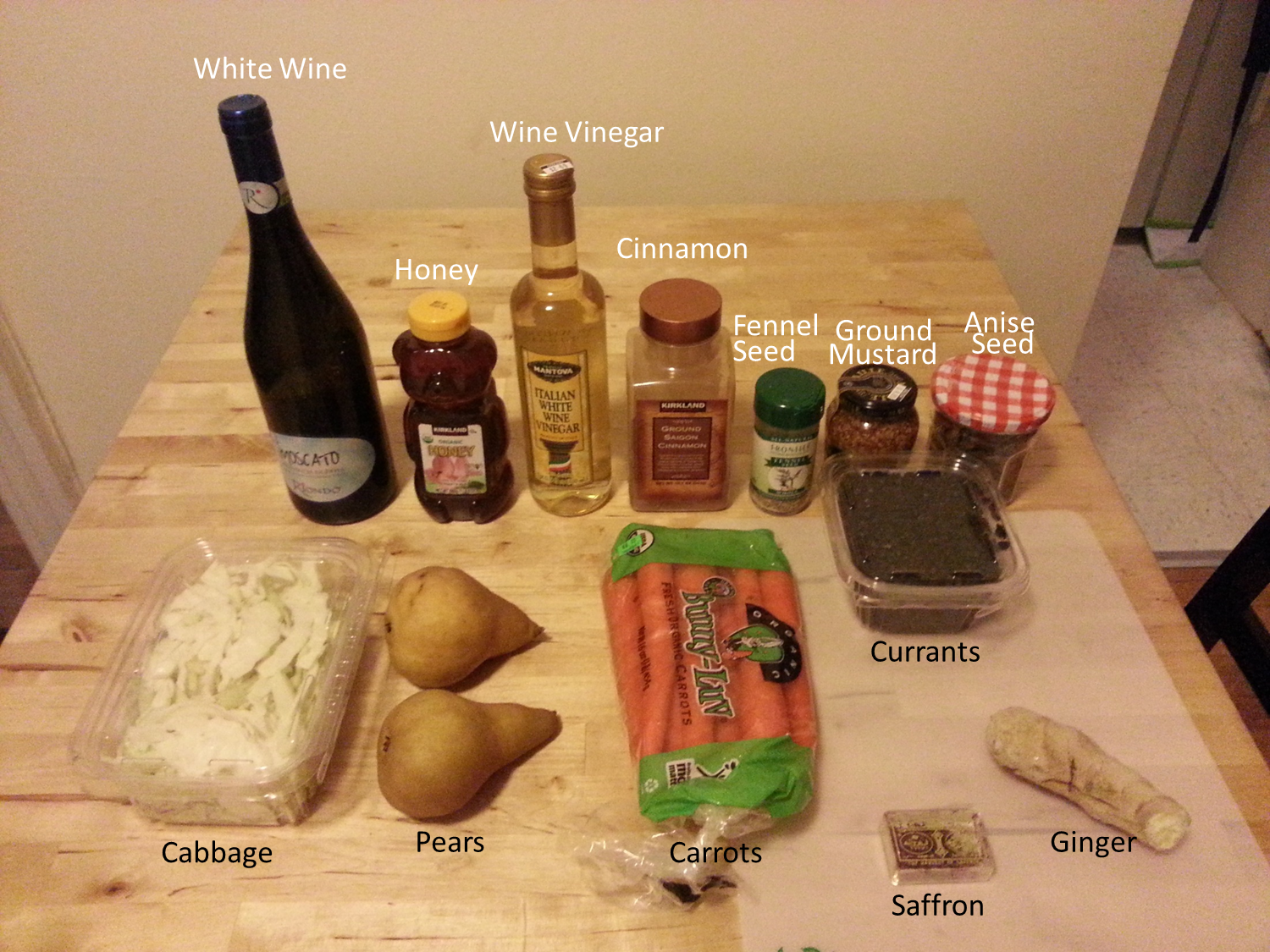
There are numerous different types of vinegar, wine, saffron, etc, and the recipe did not specify what specific ingredient we had to use. It is also possible that materials of these days are quite different from their 14th-century equivalents. For instance, what kind of pears would have been available in Europe? What kind of vinegar would someone have used? Should the currants be fresh or dried? And for more contextual questions, who would have had access to all of these ingredients?
We basically tried to get materials obtainable in the market, but when he had multiple options, we tried to choose one that goes well with the rest of the ingredients. For the vinegar, for instance, we chose wine vinegar, which would match white wine.
The recipe did not contain specific quantity information and so we decided to be pretty liberal in following the recipe. This is in part related to the nature of cooking since we just realized that when we cook something new using an online recipe, we do not faithfully follow the given recipe. We adjust amounts of ingredients depending on our preferred taste and available materials. In other words, numerous slightly different versions of compost could be made out of the recipe, and we presume there was such a possibility in 14th-century England as well.
3. Utensil
The recipe specified earthen cooking vessels over a fire but we used triply stainless steel pans over a gas flame. If we had cooked over an open wood fire, the smokiness would have complimented the flavors of cinnamon, anise, currants, and wine nicely.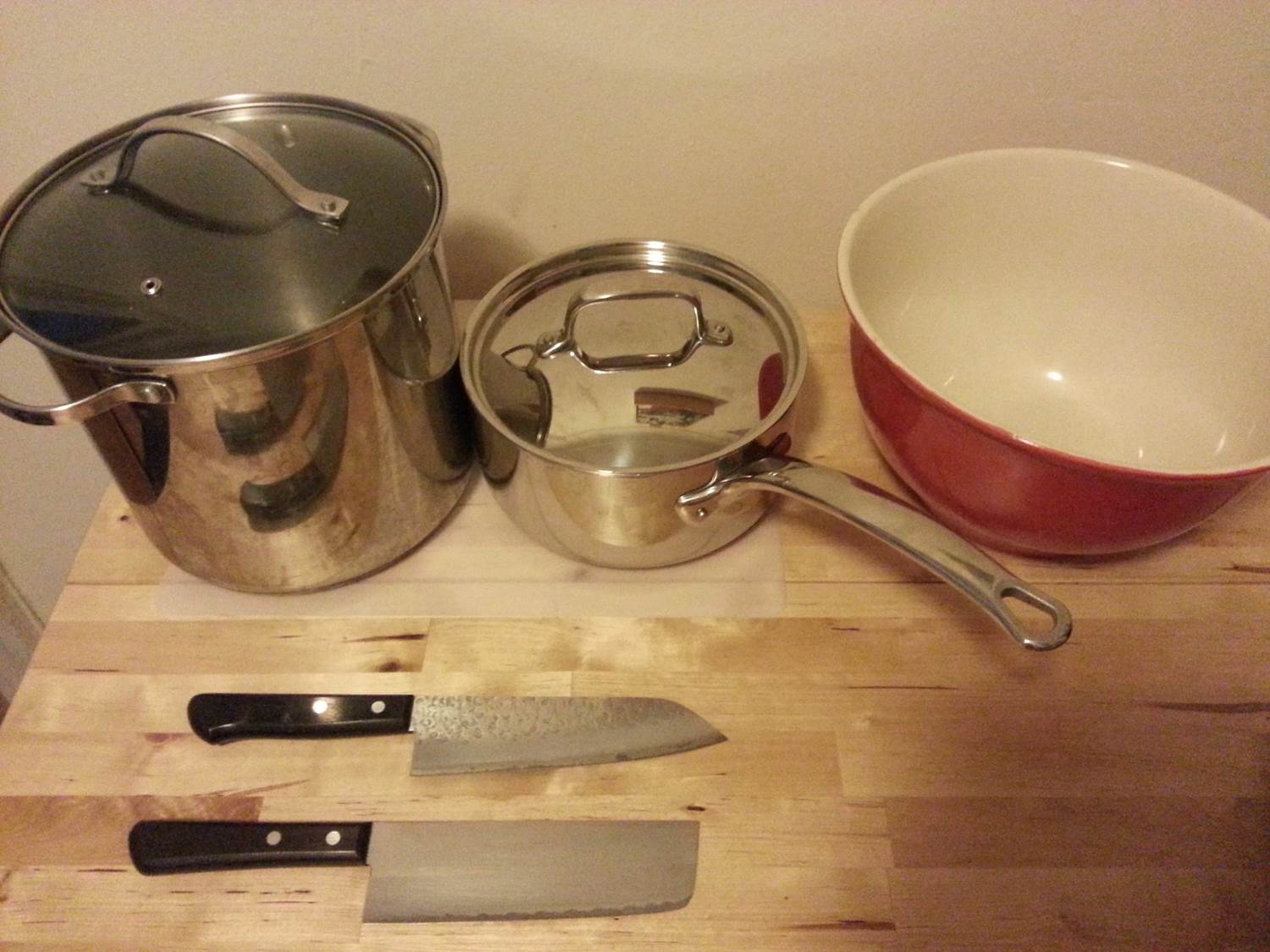
4. Preparation
1) Cutting vegetables
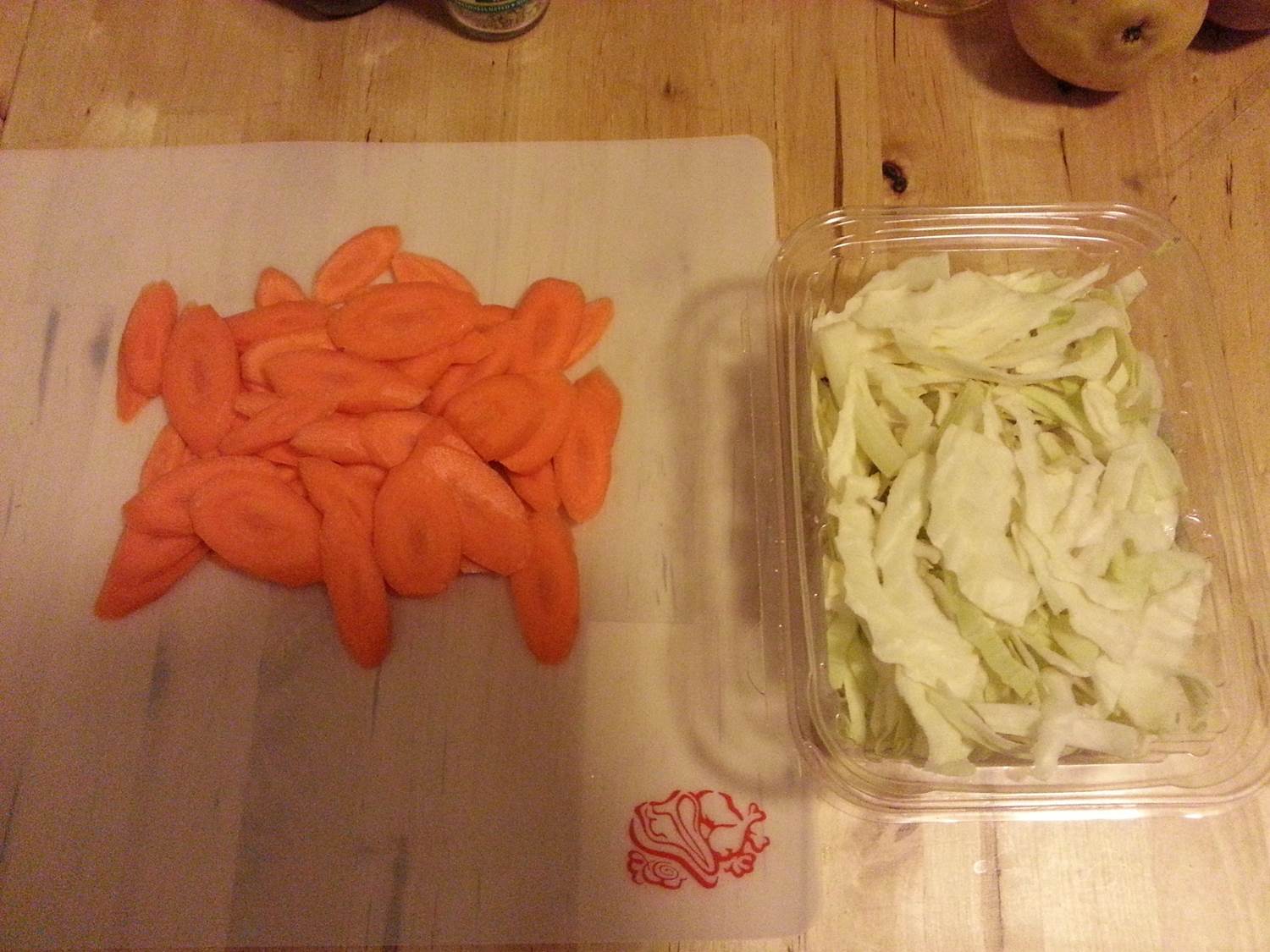
The recipe did not specify how to cut the vegetables. We decided to slice them narrowly and then cut lengthwise.
For the pears, we were not quite sure whether to peel them or not. David did brief research and figured out that for roasting, people use unpeeled pears and for other purposes they go for peeled ones. So we peeled the pears and sliced them so as to match them with the slices of other vegetables. We did not make it too thin though because pears have relatively soft texture.
2) We boiled the carrots and cabbage for several minutes, and added the pears. Cooked until tender, and then drained.
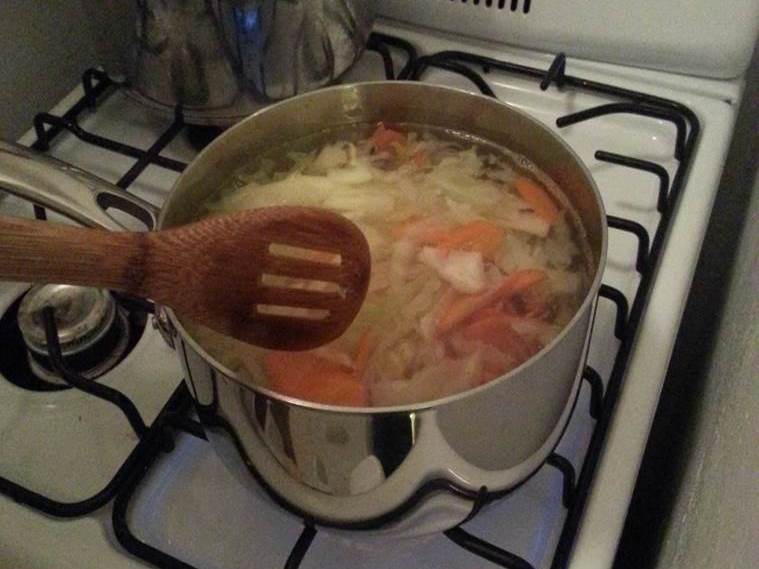
The recipe did not specify exactly how long we had to boil them. We just let our sense guide us. We also discussed why the pears should be added later; again, it is because of the soft texture of pears. We learned that having an understanding of materials could affect the way in which someone comprehends a recipe and executes it.
3) We laid the vegetables on a cheesecloth, sprinkled salt liberally, and then let cool.

4) Placed them in a large dish and added the wine vinegar, chopped ginger, and saffron. Covered it and let stand for seven hours.
Then stirred the current and seeds into the marinated vegetables.


The recipe, again, did not specify how to process ginger: to slice or chop? Given its rather strong flavor, we thought, ginger was not supposed to be used in the way to feel its texture. So we chopped it as refinely as possible.
5) In a separated pot, boiled honey, cinnamon, and wine together, skimming off the scum.
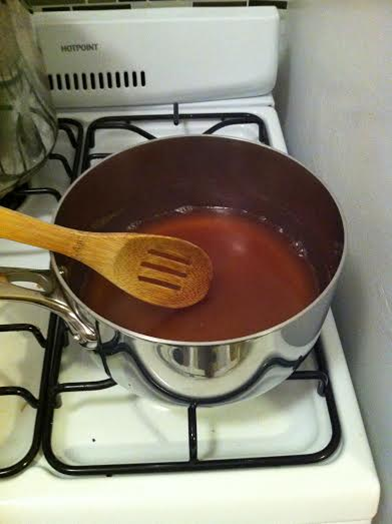
6) Removed from heat and poured over the vegetable mixture. Let cool and refrigerated.
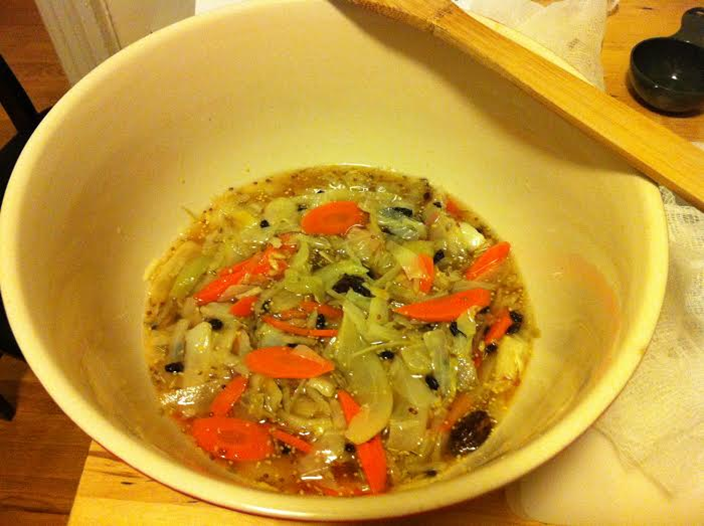
The recipe says it can be stored for a week or more, but given global warming and the fact that it was early September in New York, we thought it would not be wise to keep it in room temperature. We decided to refrigerate it.
5. Observations
We are not sure whether we made the compost that was supposed to be made out of the recipe. We know that cooking environments and conditions of materials are all different. Moreover, quantity information was obviously left out of the recipe. To us, it was quite delicious, but we can't tell if 14th-century people had the identical standard for taste.
The questions above lead us to raise another question: Who wrote this recipe? Was it an outcome of one family's unique food culture or shared rather widely? Any possibility for the existence of different recipes for compost from other households or from different parts of England? It would be useful if could collect such recipes and compare them.
The omission of numerous details including quantity info generates quite interesting questions. I wonder whether there was a general understanding of the ratios of certain ingredients (so that the author did not have to specify them in the recipe). Or was flexibility (without strict measurement) a part of their food culture? Or did the author omitted such information on purpose because (s)he did not want to reveal the crux of his or her know-how?
The omission, on the other hand, possibly gave rise to multiple different composts out of the single recipe. Maker (users) could use recipes in numerous different ways.
ASPECTS TO KEEP IN MIND WHEN MAKING FIELD NOTES
- note time
- note (changing) conditions in the room
- note temperature of ingredients to be processed (e.g. cold from fridge, room temperature etc.)
- document materials, equipment, and processes in writing and with photographs
- notes on ingredients and equipment (where did you get them? issues of authenticity)
- note precisely the scales and temperatures you used (please indicate how you interpreted imprecise recipe instruction)
- see also our informal template for recipe reconstructions